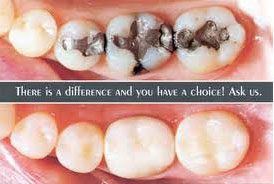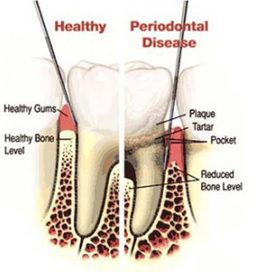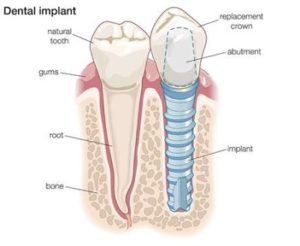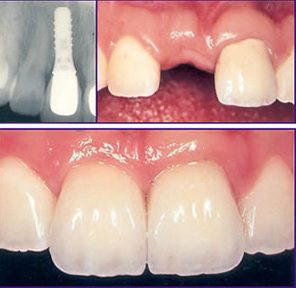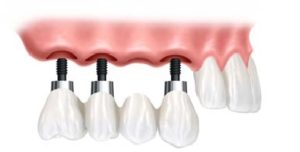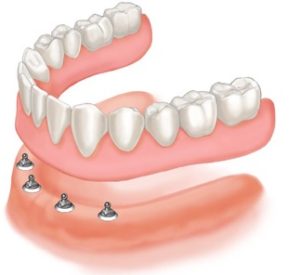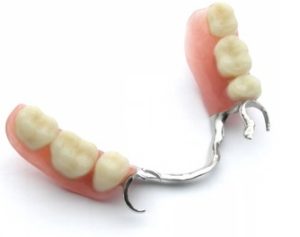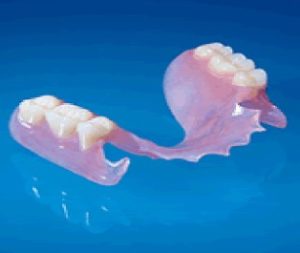When the teeth are damaged by disease, trauma, or years of wear and tear, once-simple tasks such as speaking and eating can become difficult and even painful. Fortunately, restorative dentistry services we offer are designed to return the mouth to its optimal health and ability to function.
They include:
- Composite( white/metal free ) Fillings/Bonding
- Root Canal Treatment
- Crown (caps) and Bridges
- Periodontal therapy
- Implants
- Full and Partial Dentures
Composite( white/metalfree ) Fillings/Bonding
Besides being ugly, metal fillings expand and contract with heat and cold causing the edges to wear down, leak and let bacteria into the tooth. This weakens the tooth walls and eventually causes the filling and tooth to fracture. Composite filings are a more aesthetic and conservative restoration than amalgam( silver )metal filings. The greatest advantage of composite fillings is that they bond to the tooth and hence are more conservative because we need to remove less healthy tooth enamel to prepare for them as compared to metal fillings.
With excellent hygiene and preventive care, fillings can last for years. Of course, just like a car needs repairs and eventual upgrades, fillings do as well – regardless of if they are metal or tooth colored fillings. When we see a leaking or cracked filling, we recommend being proactive and replacing it before it breaks further or causes pain. Depending on the size of the decay and the original filling, we may be able to restore the tooth with a new composite filling but if there is not enough tooth structure remaining to bond composite; a porcelain inlay, onlay or crown is indicated. We will always explain why we make a particular recommendation.
Root Canal Treatment
Over the years, root canal therapy has gotten a bad rap. In fact, so many people are convinced that getting a “root canal” is such a horrible ordeal that some prefer to live with tooth pain. In truth, however, modern root canal therapy is a gentle and practically painless procedure that can immediately alleviate nagging tooth pain. At “Only Smiles Dental”, our primary concern is your oral health. It is nearly impossible to function with a serious toothache; medications merely dull the pain, and avoiding dental care will only eventually lead to the loss of the tooth and the possible spread of dangerous infection throughout your mouth.
What exactly is root canal treatment?
Endodontic or root canal therapy is treatment that is meant to save severely decayed or broken teeth. Typically teeth with deep cavities, preexisting large fillings or teeth that are broken due to some sort of trauma require root canal therapy. The only alternative to root canal therapy is removing your tooth.
Typically, a patient will notice a gradual ache in a tooth that may require root canal therapy. At first, the pain is sporadic and over time will grow into a throbbing or severe pain that may be felt on other teeth in the area. Occasionally, there may be no pain but an abscess is discovered on a routine exam or x-ray as the disease process continues silently.
The purpose of root canal therapy is to remove all the infected pulp tissue from the tooth to allow the body to heal the destroyed bone. Our office approaches this by combining modern techniques such as use of nickel titanium root canal instruments and the introduction of the modern methods of filling and sealing root canal systems, now allowing us to complete most root canal therapies in a single visit. After root canal therapy, the tooth will require a permanent restoration (usually a crown) to minimize re-contamination of the pulp space and failure of the treatment. Occasionally, a post is placed into the canal to help build up the tooth before a crown can be placed. We will be more than happy to discuss all the treatment options that would be best for your specific situation.
Crown (caps) and Bridges
Crowns (or caps) fully cover your tooth to protect and strengthen your natural tooth structure while enhancing its appearance. Crowns are generally used to salvage teeth that have been compromised by extensive decay, trauma, or infection; however, they can also be used to cover a dental implant or to support an artificial tooth as part of a dental bridge.
Some reasons that a tooth may require a crown are the following:
- Extensively broken teeth that cannot be restored with a filling
- Large metal fillings that need replacement
- Large decay is present
- Tooth has had root canal therapy
An existing old crown that is broken or has leaking margins hence needing replacement Cosmetic reasons (dark, internally stained teeth that cannot be whitened , to unravel crowded teeth when patient does not want braces, old crown has a dark line at the edge)
A dental bridge is an appliance used to replace a missing tooth or several missing teeth. It is typically comprised of an artificial tooth, or pontic, attached to a dental crown on either side. Dental bridges provide outstanding long-term replacements for missing teeth. By filling the gap left by a missing tooth, you help to ensure that the adjacent teeth don’t shift out of their optimal position. The integrity of your bite will be restored, and you will be able to chew and speak with renewed ease. Because dental bridges are fixed in the mouth, they will not slip out of place or fall out. With proper maintenance, they can last for several years giving you a beautiful, healthy-looking smile.
There are several types of crowns and bridges available today. Porcelain (tooth colored) crowns continue to be the most popular mainly because they look so much like real teeth.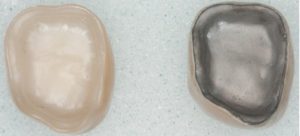
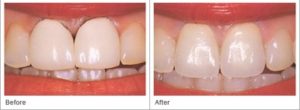
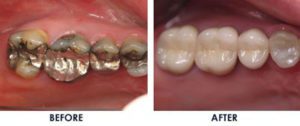
You can be rest assured, whatever your dental needs, we will provide you with the most natural looking restorations possible using only the highest-grade materials.
Periodontal therapy
Gingivitis is inflammation and irritation of the gum tissue without loss of bone. It is usually caused by bacteria and food particles that build up in the small gaps between the gums and teeth. Brushing and flossing on a daily basis and going to your dentist every 6 months for your regular check-ups and cleanings could prevent gingivitis. If gingivitis is left untreated, it will progress to periodontal disease.
Periodontal disease is severe inflammation of the gums along with bone loss.
Some signs of periodontal disease are listed below:
- Bleeding, red or swollen gums.
- Bad breath
- Gum recession (teeth will appear longer in size because there is less gum covering them)
- Deep pockets between the gum and teeth
- Loose teeth
Treatment for periodontal disease depends on how advanced it is. Treatment may involve scaling and root planning (deep cleaning), local antimicrobial medication (Arestin), gum contouring, or periodontal surgery.
If left untreated, periodontal disease will cause infections, pain, and loss of teeth.
Notice the bone loss and deeper pocket when probing when periodontal disease is present as compared to healthy gums and bone.
Implants
We understand that people of all ages loose their teeth for a variety of reasons be it decay, gum disease, or trauma. Whatever the reason for the loss, it is important to restore these spaces to prevent more dental complications in the future. Leaving spaces in your mouth will cause other teeth to shift which can then lead to gum disease, cavities, and loss of other teeth. Dental implants are safe, medically proven, aesthetic alternatives to traditional crowns, bridgework, and dentures. Unlike a bridge or partial dentures, dental implants allow you to replace multiple missing teeth without having to involve or alter other teeth.
The dental implant is a sturdy titanium post that is surgically embedded into the jawbone, where it serves as a replacement for the original tooth root. Once the titanium has integrated with the jawbone and the gum tissue has healed around the implant (a process that takes between three and six months), a realistic-looking artificial tooth is attached to the post. Because titanium is not recognized by the human body as a foreign material, the likelihood of implant rejection is extremely small.
Dental implants allow patients to regain the freedom that they enjoyed with their original teeth. Implants can be used to support a single crown, a bridge, or even a full set of dentures.
Just as a natural tooth has a root, think of an implant as an artificial root. Just as you only see the crown of your natural tooth in your mouth, you only see the artificial crown of the implant. The additional component is an abutment which serves as the connection part between the implant and the crown.
A missing front tooth replaced by a dental implant to look and function just like a natural tooth. Only when looking at the x-ray can you tell that it is an implant.
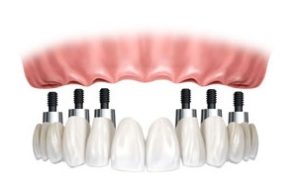
Full, Partial and Immediate Dentures:
If you are missing most or all of your natural teeth and dental implants are not an option, full or partial denture may be what you need. Full and partial dentures not only restore your ability to chew food and speak properly but can also restore your confidence by giving you a more natural and younger appearance.
A partial denture is used to replace one or more missing teeth by using your remaining natural teeth as anchors to hold it in place. Unlike a fixed bridge, a partial denture is type of “removable bridge” that needs to be taken out at night and after meals to clean. There are two types of partial dentures – metal based and flexible rubber based. We will help you decide which type may be best for you.
Metal based removable partial denture.
Flexible rubber based removable partial denture.
Sometimes it is necessary to extract all of a patient’s upper or lower teeth. While this can be devastating, complete dentures can provide a second chance at a beautiful smile.
We usually recommend that after extractions are completed, you wait between 2-4 months to start the process of denture fabrication to allow the bone and gums to heal and shrink.
However, being without any teeth for so long can be quite daunting. With immediate complete dentures, you can get a full set of dentures on the same day you have your extractions. An immediate denture would serve as a transitional denture for up to six months so that you can eat, smile, and function while your gums and bone continue to heal. As you heal, your immediate denture will loosen and not fit well. So, it is often necessary to reline your immediate denture or make a new denture altogether after this period of six months to allow for a more accurate fit of your denture.
As one of our patients, you can expect that we will continue to provide you with the care and support you need to maintain your dentures after you have received them. We want to be your partners in good oral health for a lifetime, and we will be here for any adjustments etc, every step of the way.

